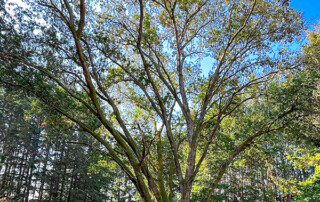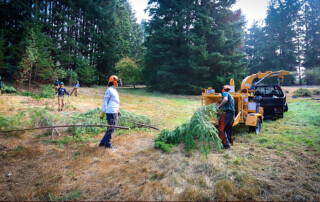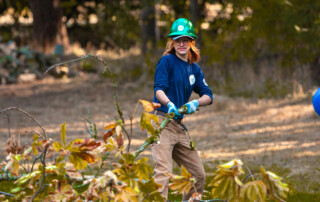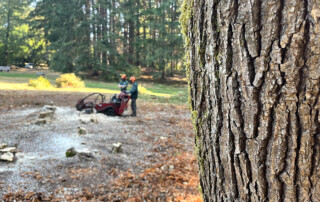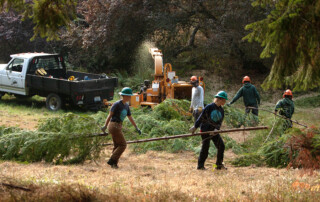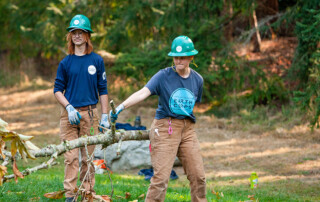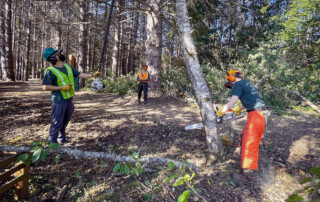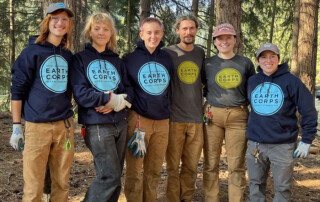Moritani Preserve’s newest natural wonder isn’t so new – 100 years by some estimates, and that’s probably on the low end. Stately, leafy, sprawling across the open blue sky, yet always hidden just beyond plain sight.
You can call it Garry. Maybe.
“Look at this oak, isn’t it magnificent?” muses Lydia Roush, natural resource manager for Bainbridge Metro Parks. “It’s much more aesthetic to walk through here and see this huge, majestic and very old oak. The horse chestnuts were growing into it and shading it out. We’re hoping now that it’s got more sun and more space, it’ll perk back up and shoot out some new limbs in the spring.”
The century-old oak came to light this past week as the Park District felled a clump of giant chestnut trees that had through the years grown up in front but found themselves on the list of undesirables. Chestnut sprouts were appearing in the meadow and around the preserve.
The specific variety of oak is still in question. It could be a Garry oak (Quercus garryana) – so known in Washington, although “Oregon white oak” to our parochial neighbors to the south – or an English white oak (Quercous robur). The issue will be settled when the tree next produces acorns and the peduncle, or stalk, shows one variety or the other.
Individual Garrys can grow up to 65 feet tall with lifespans of 500 years.
“It may be pushing 200,” Roush says of the Moritani tree. “It takes them a long time to get that big.”
The four-day restoration project targeted “weeds of concern” – trees not yet formally added to the invasives list, but trending toward nuisance.
Out: English horse chestnuts, a black locust, English hawthorn and various bird cherries – non-natives all – and a handful of young Douglas firs that were volunteering at the edges of the preserve’s central meadow.
Going in: Oregon grape and white-flowering serviceberry (Amelanchier arborea), a native pollinator known for its clusters of edible berries in summer. New Garrys will be planted in the area of the oak.
“It will have native companions,” Roush says, “and when he passes he’ll also be replaced by a Garry oak.”
A five-person crew from Seattle-based EarthCorps boosted the project, clearing debris and wrenching out invasives from the Moritani forest floor.
Moritani Preserve was created by donation on the site of a historic Japanese American farmstead, and recently celebrated its fifth birthday. Restoration under an updated five-year management plan will resume this winter with thinning of stressed, monocultural fir stands along the west and north park boundaries.
Donations to support the work can be made to the dedicated Friends of Moritani Preserve Fund through the Bainbridge Island Parks & Trails Foundation. The Foundation is raising $20,000 for the next phase of the project.
“Everytime I walk through Moritani Preserve, I reflect on what a gift it is to have this green treasure right in the heart of downtown,” says Mary Meier, Parks & Trails Foundation executive director. “It is so gratifying to see people who live and work downtown show up at work parties and support this next phase by learning, volunteering, and giving so generously.”
SUPPORT MORITANI PRESERVE RESTORATION: Make a gift to the Moritani Preserve restoration and stewardship through the Bainbridge Island Parks & Trails Foundation here. Donations support restoration of the preserve’s forests with thinning and introduction of varied native tree and shrub species in 2023.




